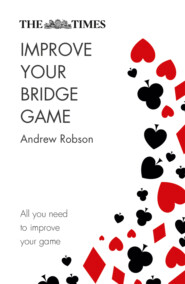скачать книгу бесплатно
) is a strong bid (Tip 67). Whether opening or overcalling pre-emptively, note that you have shown your hand so should not bid again (Tip 68).
Meanwhile, the partner of the pre-emptor should simply ‘put up or shut up’ (Tip 69). Because the pre-emptor will be profoundly short outside his suit, partner should value aces (especially) and kings, but attach little value to outside queens and jacks (Tip 70). Sometimes, partner may consider raising pre-emptively (with a poor defensive hand), and the more cards he has in the pre-emptor’s suit, the more bold he should be, generally bidding to the ‘level of the fit’ (Tip 71).
Pre-empting is fun – although you will occasionally get caught for a big penalty. Defending against opposing pre-empts is less fun – you have to start at a high level and the splits are likely to be bad (Tip 72). However, do not be too frightened to enter the bidding – in spite of the high level; bear in mind that one opponent is very weak, so your partner rates to hold some values.
A reasonable rule of thumb is to double (for take-out) if you would have doubled a one-level opener in the suit (Tip 73); and overcall 3NT if you would have overcalled with 1NT over a one-level opener, bearing in mind that it is especially important to have a stopper in the pre-emptor’s suit. There is a good chance of being able to shut the pre-emptor out of the play (Tip 74). But without a stopper (you cannot bid 3NT), or a good suit (you cannot overcall), or insufficient length in the other major(s) (you cannot double), you have little option but to go quietly (Tip 75).
TWO-LEVEL OPENERS Whereas the three-level is reserved for weak openers, the two-level is used for strong ones. 2NT is the only bid that can be passed by partner, and should be opened with a balanced hand (including a 5332 shape with a good five-card suit) and 20-22 points (Tip 76).
2
/
/
openers show unbalanced 20-22 point hands with good five/six card suits. But be prepared to upgrade a powerful-looking hand with just under 20 points if it has ‘eight playing tricks’ (Tip 77). You are sometimes stuck when you have 20-22 points with a good club suit, as 2
shows any 23+ point hand. In this case it is better to open 1
and hope the auction does not continue pass-pass-pass (Tip 78).
2
/
/
openers must be kept open a round by partner, even with nothing (Tip 79). With fewer than eight points, make the conventional negative reply of 2NT (Tip 80). The negative reply to 2
is 2
(0–7 points), on grounds of economy (Tip 81). These negative responses prioritise – such that all other bids (positives) show eight(+) points (Tip 82).
SLAMMING The ultimate goal in the bidding is to bid and make all 13 tricks on a deal – a grand slam. This is generally inadvisable – it’s tough enough to make all 13 tricks, let alone to bid for them and risk losing everything if even one trick gets away.
More reasonable is to bid for 12 tricks – a small slam – which will be possible about one deal in fifteen. 33 partnership points is the guideline for contracting for a small slam – though less if there is a big fit and interesting distributions. A small slam is doomed, however, if the opponents have two aces (unless you have a void in one of those two suits).
Because of the importance of aces, the bid of 4NT ‘Blackwood’ is used to ask partner how many aces he possesses. But beware when clubs (and to a lesser extent diamonds) are trumps – the reply to Blackwood (5
= 0 aces; 5
= 1; 5
= 2; 5
= 3) may take you overboard (Tip 83). If the reply indicates that one ace is missing, go ahead and bid the small slam (Tip 84); to bail out in Five of the trump suit would be inconsistent with your decision to go slamming.
Blackwood is useful but, because it only solves the problem of how many aces partner has, only use the convention if that is the key piece of information about which you wish to know (Tip 85). If you are interested in a grand slam and the reply to Blackwood indicates that all the aces are present, you can follow with 5NT to ask for kings. But because grand slams are generally to be avoided, it will rarely be right to do so (Tip 86).
Note that the Blackwood bidder is in control – do not overrule him (Tip 87). Finally note that 4NT is not always asking for aces. If the immediately preceding bid was in notrumps, it is a quantitative invitation to 6NT, asking partner if his hand is minimum or maximum for his bidding to date (Tip 88).
Bidding to a sensible contract is one thing. Making it is quite another…
(#ulink_bb964aef-b033-53bc-860c-2fdaed610b14) NB: There is much to be said for not playing ‘reverses’. Although you will occasionally bid too high, at least you KNOW that partner has six cards when he repeats his suit (provided he opens/rebids notrumps with a 5332 shape).
Вы ознакомились с фрагментом книги.
Для бесплатного чтения открыта только часть текста.
Приобретайте полный текст книги у нашего партнера:
